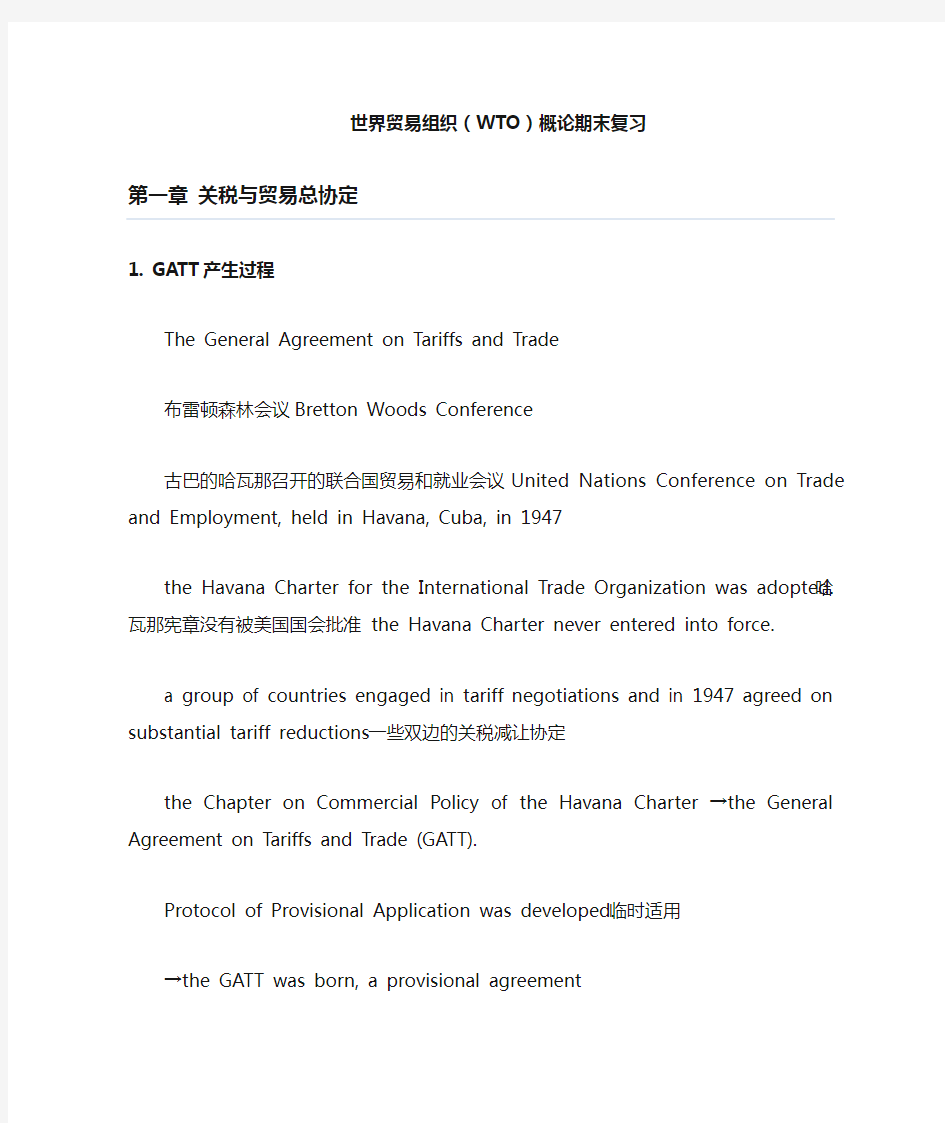
世界贸易组织(WTO)概论期末复习资料
- 格式:docx
- 大小:76.02 KB
- 文档页数:7


世界贸易组织(WTO)概论期末复习
第一章关税与贸易总协定
1. GATT产生过程
The General Agreement on Tariffs and Trade
布雷顿森林会议Bretton Woods Conference
古巴的哈瓦那召开的联合国贸易和就业会议United Nations Conference on Trade and Employment, held in Havana, Cuba, in 1947
the Havana Charter for the International Trade Organization was adopted. 哈瓦那宪章没有被美国国会批准the Havana Charter never entered into force.
a group of countries engaged in tariff negotiations and in 1947 agreed on substantial tariff reductions一些双边的关税减让协定
the Chapter on Commercial Policy of the Havana Charter →the General Agreement on Tariffs and Trade (GATT).
Protocol of Provisional Application was developed. 临时适用
→the GATT was born, a provisional agreement
The Protocol of Provisional Application stated that the governments involved would apply Parts I and III of the GATT, however. Part II (mostly on non-tariff barriers) would apply only to the fullest extent "not inconsistent with existing legislation".
Entered into force: 1 January 1948
Terminated on 31 December 1995
Eight "rounds" of multilateral trade negotiations
乌拉圭回合:125个参加方在协议上签字,8年谈判。
2. GATT的局限性
(1)“祖父条款”的存在大大削弱其法律效力;
(2)非国际组织,导致对司法裁决的权威性受到严重影响;
(3)一系列“假设”与漏洞的存在使缔约方的“越轨行为”难以受到约束;
(4)调整的对象主要是货物贸易及与之相关的关税与非关税措施,对农产品、纺织品及服装的约束有限;
3. World Trade Organization
WTO is the only international body dealing with the rules of trade between nations.
At its heart are the WTO agreements, negotiated and signed by the bulk of the world's trading nations.
These documents provide the legal ground-rules for international commerce. They are essentially contracts, binding governments to keep their trade policies within agreed limits.
the goal is to help producers of goods and services, exporters, and importers conduct their business.
意义:
建立了一个强大的以规则为基础的多边经济贸易体制
增加了世界贸易的可预见性、稳定性
推动了世界贸易的增长,带来了更多就业机会、投资机会,提高了福利水平Membership—150countries and regions
4.WTO规则体系
❖一个基本法
❖二个程序法
❖三个实体法
❖四个诸边贸易协议
❖五个服务部门的贸易协议
❖六个非关税壁垒协议
❖七个货物贸易的多边协议
5.WTO的法律地位
❖独立的法律人格,拥有独立的财产,可以缔结条约和提起诉讼。
❖世界贸易组织各成员应向世界贸易组织提供其履行职责所必需的特权和豁免权。
❖世界贸易组织官员和各成员方代表在其独立执行与世界贸易组织相关的职能时,享有每个成员方提供的所必需的特权和豁免权。
6.WTO vs GATT: main differences
a. Nature 性质
❖The GATT ——with no institutional foundation,applied on a provisional basis.
❖The WTO —— a permanent institution with a permanent framework and its own secretariat.永久性国际机构
b. Scope 覆盖面
❖The GATT rules —— applied to trade in goods. 货物贸易
❖The WTO Agreement —— covers trade in goods, trade in services and trade-related aspects of intellectual property rights. 覆盖更多方面
c. Approach
❖the GATT—— a series of new agreements plurilateral , causing a fragmentation of the multilateral trading system.
❖The WTO ——been adopted, and accepted as a single undertaking: the Agreements all multilateral.
d. Dispute settlement 争端解决机制
❖The WTO dispute settlement system——
has specific time limits;
operates more automatically,
has a permanent appellate body to review findings by panels.
more detailed rules on the process of the implementation of findings.